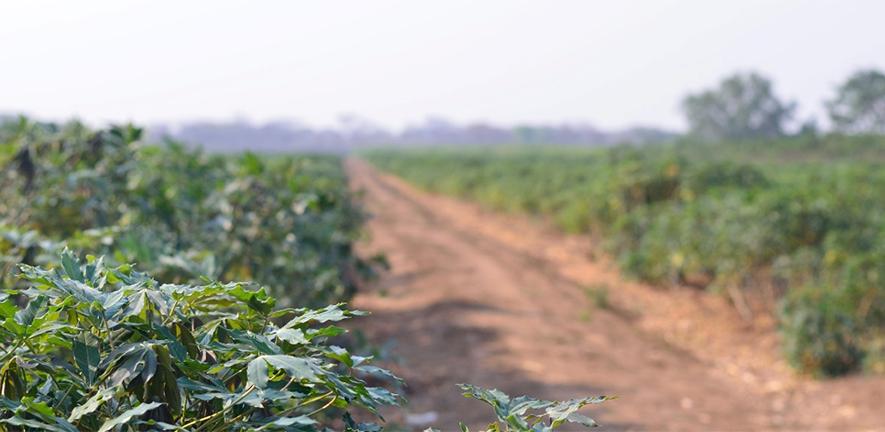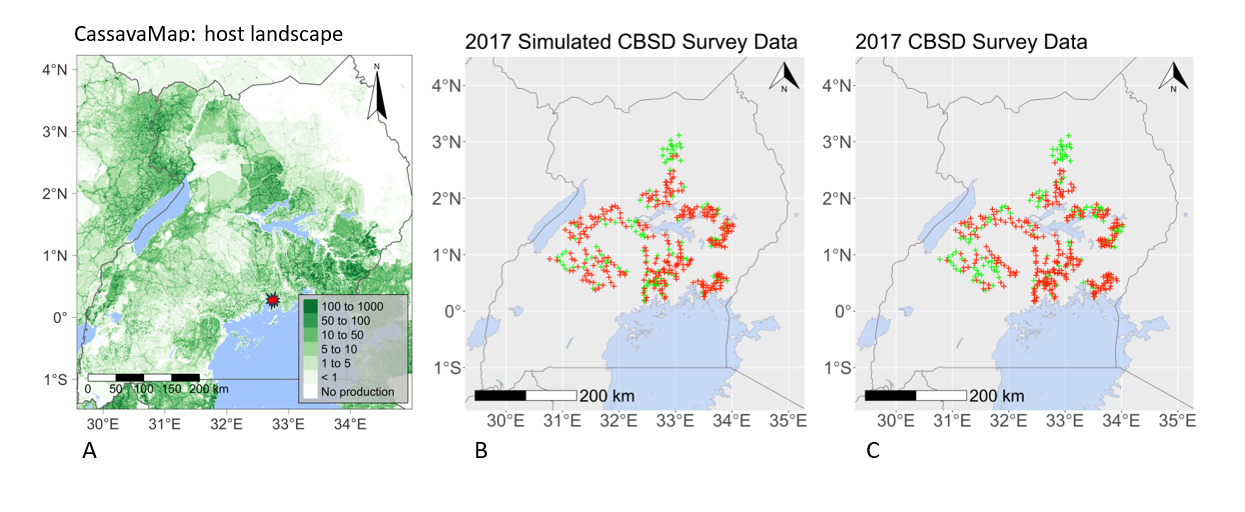
Submitted by Anonymous on Tue, 22/08/2023 - 13:29
Cassava (Manihot esculenta) is one of the most important staple food crops produced globally, primarily grown in low-input subsistence farming systems in the tropics and subtropics. In Africa alone, an estimated 800 million people rely on cassava for their primary calorific intake.
Threatening food production
In recent years cassava production in sub-Saharan Africa has come under increasing pressure due to the rapidly expanding range of cassava brown streak disease (Figure 1). The disease, which causes necrosis of the edible root tissue infected by ipomoviruses, can be transmitted across cassava-growing regions in two ways. Firstly, vectored by Bemisia whitefly, which feed on the aerial tissues of infected plants causing cross contamination within and between field crops. Secondly, through human movement of virus-infected propagated cuttings that are traded, transported and planted for the next season’s harvest.
Cassava brown streak disease was first reported in Uganda in 2004 but has since been detected widely across countries in East and Central Africa, now reaching as far as the north central districts in the Democratic Republic of the Congo. Continued westward expansion is now a significant threat to food security and economic stability in the major cassava-producing regions of Central and West Africa.
Figure 1: Cassava showing symptoms of cassava brown streak disease in leaves and tubers caused by infections of ipomoviruses.
Predicting epidemics
Landscape models capable of predicting where and when cassava brown streak disease will occur in a new region are essential tools for ensuring that national strategies can be prepared to mitigate the threat to cassava production areas. This is central to research carried out by the Epidemiology and Modelling Group in the Dept. of Plant Sciences, who develop mathematical models to assist national decision makers in addressing a number of vital questions; i) when will the virus cross international borders to arrive in unaffected countries in West Africa; ii) how can these disease-free countries optimise surveillance for early detection and be ready for outbreaks and iii) what strategies can the increasing number of disease-endemic countries use to minimise the impact on farm businesses and food security?
However, accurately predicting the arrival of a crop pest or pathogen over large regions in sub-Sahara Africa is extremely challenging due to the complexity of crop landscapes within and between countries. In a recent study, members of the Cambridge team used surveillance data for cassava brown streak disease collected by colleagues in Uganda, to design and validate a stochastic epidemic model of the virus, as it spread to new districts. The new model provided a framework for analysing the spread of cassava brown streak disease (Figure 2), taking into account the variation in the distribution of the cassava fields and the prevalence of the whitefly vector across the Ugandan landscape.
Figure 2: Maps representing the rasterised data-driven model layers: (A) the model cassava landscape, representing the number of fields at a 1 km2 resolution derived from the digital resource, CassavaMap. Testing the model by (B) simulating the spread of cassava brown streak disease using data from 2004 to predict its range in 2017, versus (C) the actual survey data collected in 2017 from the Ugandan field surveys.
Developing a model framework for future management strategies
Moreover, the research team designed the model to simulate the impact of planting virus-free cassava cuttings (clean seed programme) in localised areas around Kampala, and were able to demonstrate its use for predicting and analysing the impacts of disease-management scenarios. Gaining an insight into the regions threatened by epidemic outbreaks of cassava brown streak disease is key in supporting the chain of events that will ensure timely guidance and resources are available to agencies and farmers to minimise the risk of crop losses.
Read the paper: Godding, D., Stutt, R.O.J.H., Alicai, T., Abidrabo, P., Okao‑Okuja, G., Gilligan, C.A. (2023), Developing a predictive model for an emerging epidemic on cassava in sub‑Saharan Africa. Scientific Reports, 13:12603, https://doi.org/10.1038/s41598-023-38819-x
Written by Alison Scott-Brown of the Epidemiology and Modelling Group, from whom more details may be obtained.


